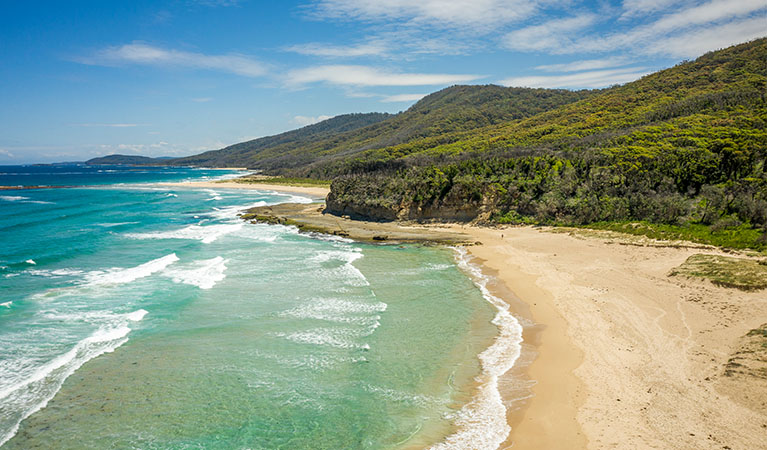Murramarang National Park
Overview
Book a cabin or pitch a tent at Murramarang National Park near Batemans Bay on the NSW south coast. You'll spot eastern grey kangaroos and abundant birdlife while enjoying opportunities to walk, fish, swim or surf.
Read more about Murramarang National Park
Spanning 44km of dramatic coastline, and home to the spectacular 3 day Murramarang South Coast Walk, Murramarang National Park is the ultimate spot to soak up some sun and explore the cliffs, headlands and pristine beaches of the NSW south coast. Be sure to pack your swimmers to hit the surf, binoculars for spotting peregrine falcons and sea eagles soaring high above the cliffs, and your fishing rod to catch dinner.
This is one of the rare spots in Australia where the spotted gums grow right down to the ocean, offering plenty of shade in the warmer months and a stunning backdrop for a nature escape all year round. When you're ready to take a break from the stunning beaches you can opt to canoe or walk around Durras lake instead. The Durras lake discovery trail is perfect for kids.
Murramarang is a great place to spend the day but if you’d like to stay longer, there's a good choice of campgrounds, including caravan and motorhome sites with a range of facilities. If you don’t feel like camping, book into one of the park accommodation options like Depot Beach cabins, Pretty Beach cabins, Pebbly Beach shacks or Yellow Rock beach house.
Local alerts
For the latest updates on fires, closures and other alerts in this area, see https://www.nationalparks.nsw.gov.au/visit-a-park/parks/murramarang-national-park/local-alerts
Map
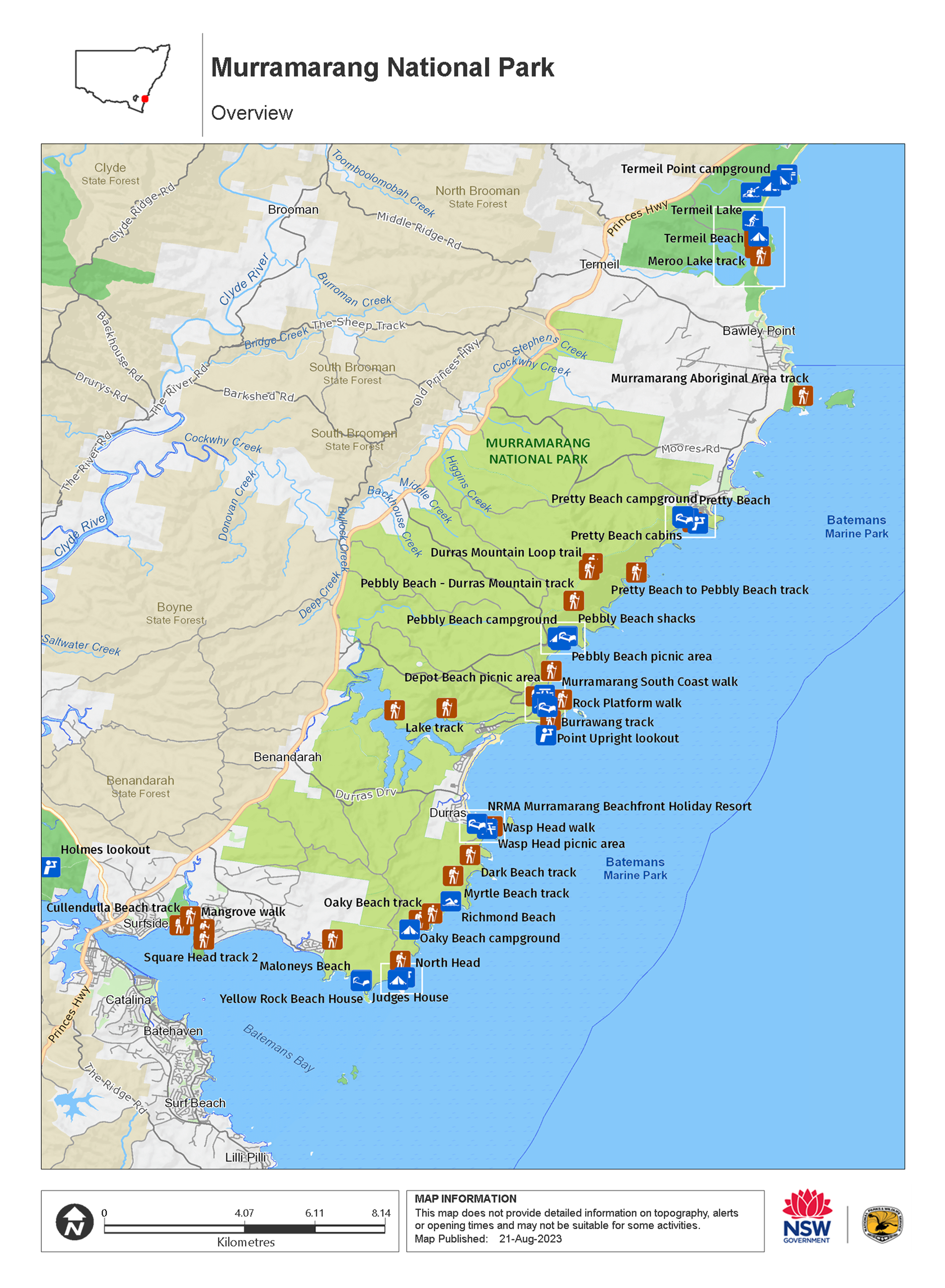
Map
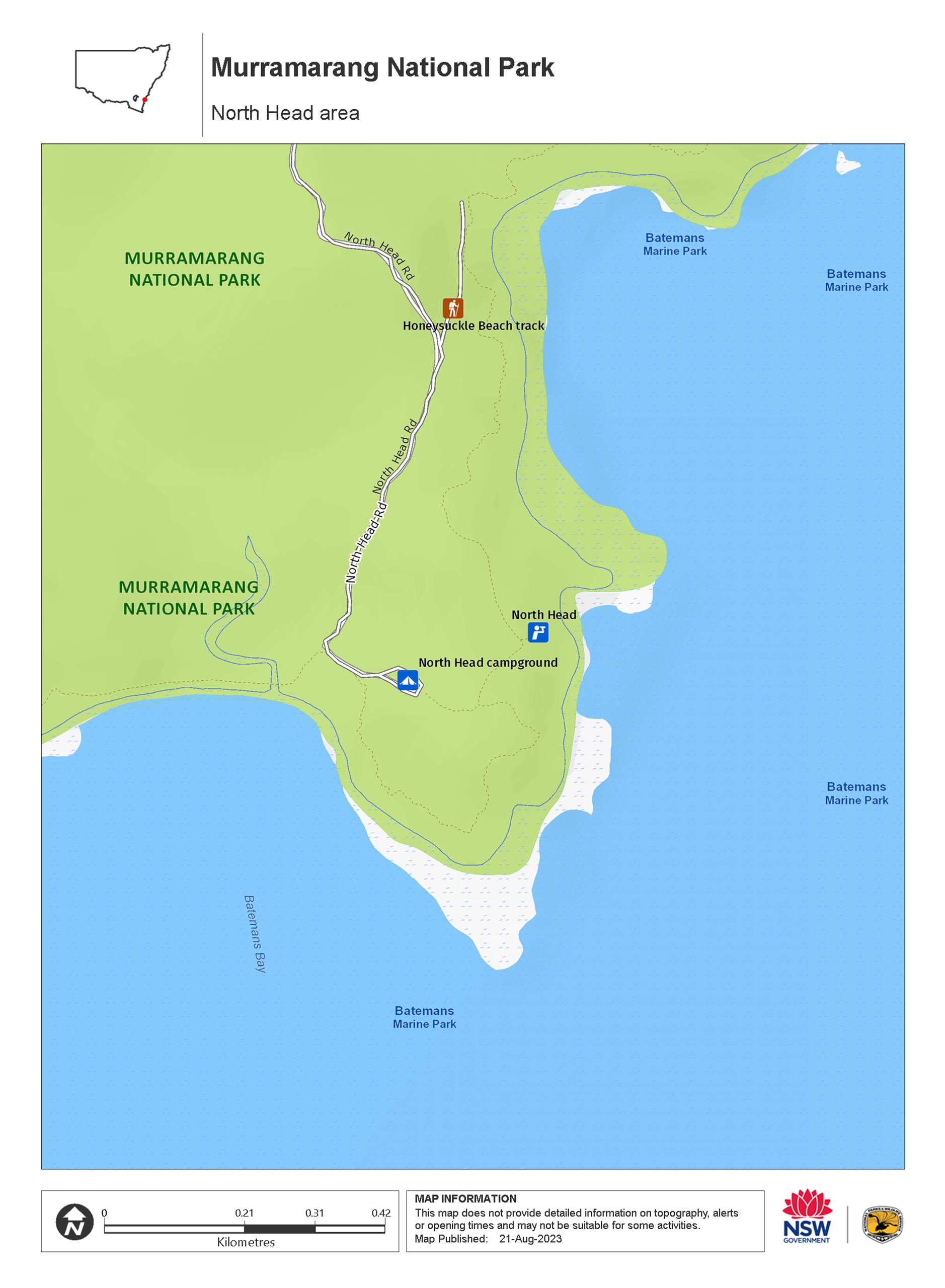
Map
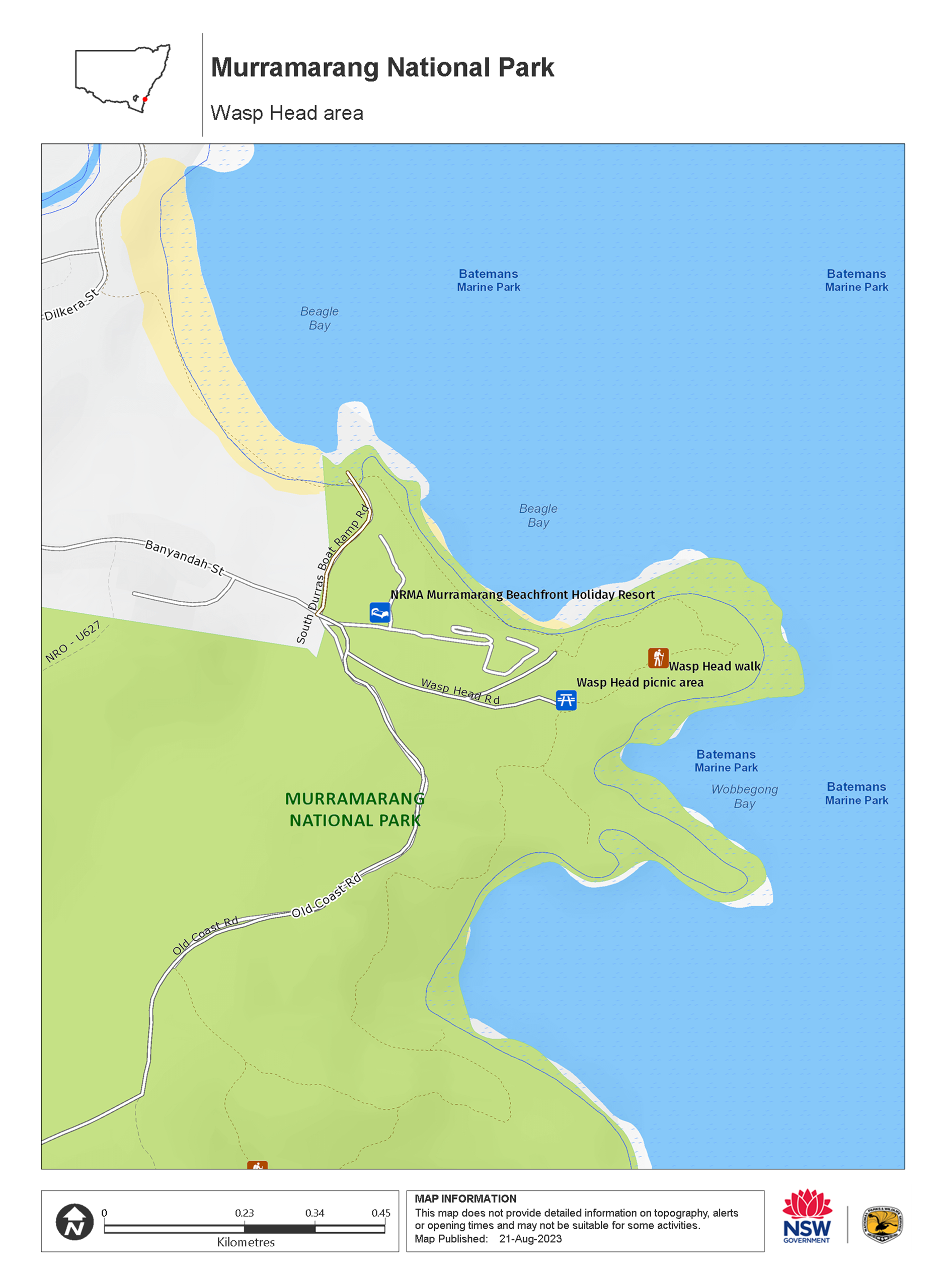
Map

Map

Map
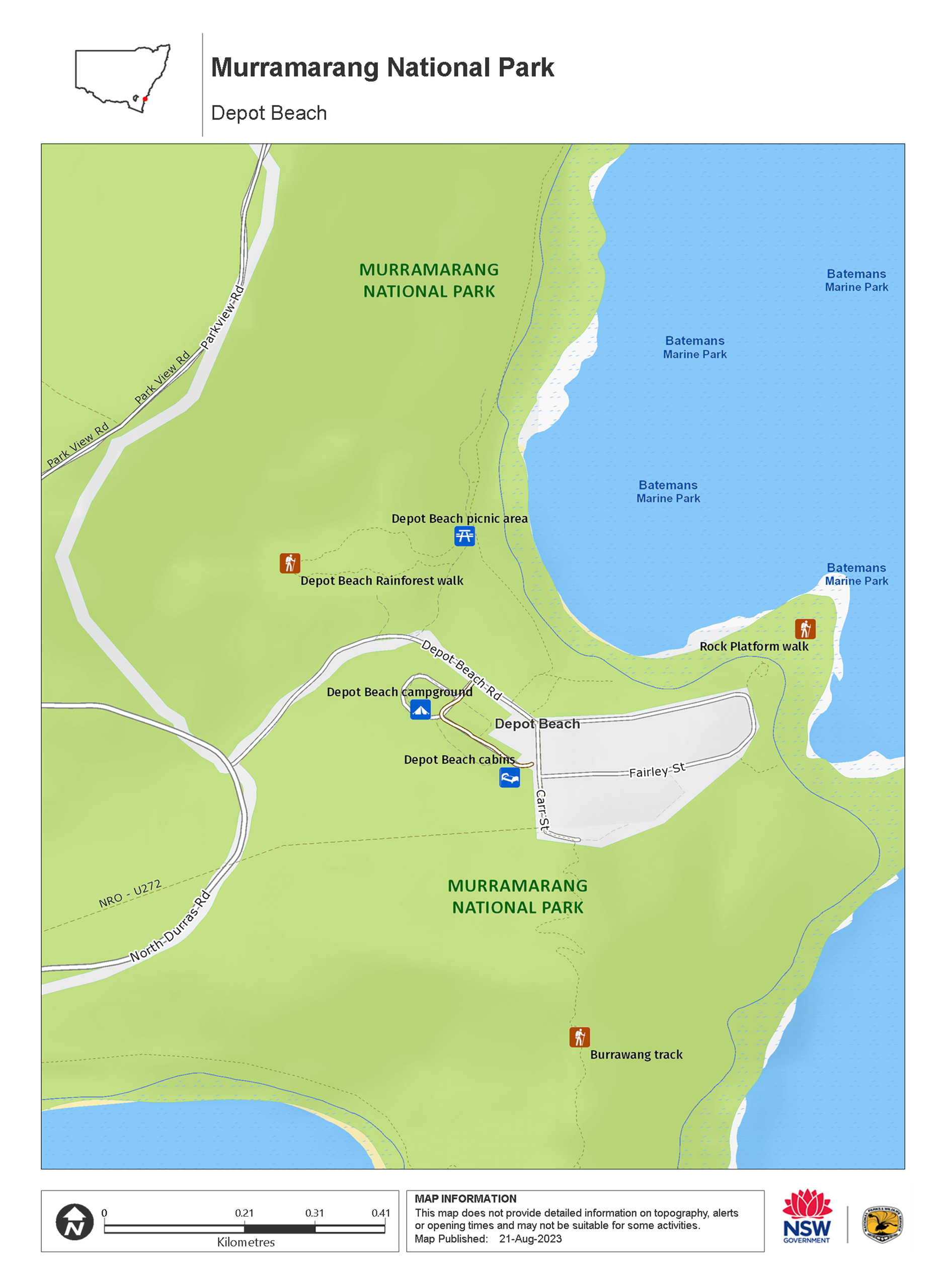
Map legend

Contact
- in the South Coast region
Murramarang National Park is always open but may have to close at times due to poor weather or fire danger.
-
Park entry fees:
$8 per vehicle per day. The park has pay machines - cash and credit cards accepted. Card only at Pretty Beach.
Buy annual pass. -
-
Ulladulla office
02 4454 9500
Contact hours: Monday to Friday, 9am to 4pm. - Lot 9 Blackburn Industrial Estate, 6 Coller Road Ulladulla NSW 2539
-
Email: npws.shoalhaven@environment.nsw.gov.au
-
Ulladulla office
-
-
Depot Beach office
02 4478 6582
Contact hours: Open daily, 10am to 4pm variable. Closed Christmas Day. - 2B Depot Beach Road, Depot Beach NSW 2536
-
Email: depot.beach@environment.nsw.gov.au
-
Depot Beach office
-
-
Pretty Beach campground
02 4457 2019
Contact hours: Open daily, 10am to 4pm variable. Closed Christmas Day. - 1 Pretty Beach Road, Pretty Beach NSW 2539
-
Email: pretty.beach@environment.nsw.gov.au
-
Pretty Beach campground
-
-
Nowra office
02 4428 6300
Contact hours: Monday to Friday, 9am to 4pm. - 104 Flatrock Road, Mundamia NSW 2540
-
Email: npws.shoalhaven@environment.nsw.gov.au
-
Nowra office
Visitor info
All the practical information you need to know about Murramarang National Park.
Maps and downloads
Nearby towns
Batemans Bay (11 km)
Batemans Bay is a bustling coastal town with majestic seascapes. It's located on the estuary of the Clyde River.
Ulladulla (33 km)
Ulladulla is close to several wonderful national parks. Morton National Park, to the west, is home to Pigeon House Mountain, a local landmark which is a popular climb. Murramarang National Park, between Ulladulla and Batemans Bay, has beautiful coastal walks, beaches and camping sites.
Mollymook (35 km)
Mollymook is a quiet, leisurely coastal town with beaches that draw summer crowds. It's set on hills rising from the coast into pastureland.
Learn more
Murramarang National Park is a special place. Here are just some of the reasons why:
Rich Aboriginal cultural heritage

Aboriginal people have a long connection with the Country of Murramarang National Park, and this continues to the present day. The south coast headlands have long been a focus for economic life, giving easy access to the food resources of both the sea and the land, and plants within the park provided medicines and shelter. There is much evidence of the past today, including shell middens, tool manufacturing sites and indications of a specialised industry producing bone points and fishing hooks. Take a walk around Murramarang Aboriginal Area, near Bawley Point - there's a complex of middens that are of great cultural value.
- Then and now: Aboriginal culture Then and now: Aboriginal culture is a Stage 4 (Years 7-8) school excursion in Murramarang National Park, focused on History. Through story and creative expression, the life and culture of the local people are shared.
- Then and now: Aboriginal culture Aboriginal culture then and now is a Stage 2 (Years 3-4) school excursion in Murramarang National Park, focusing on Geography and History. Through story and creative expression, the life and culture of the local people are shared.
- Then and now: Aboriginal culture This excursion experience has been updated and is now being delivered in line with the new NSW Department of Education Curriculum. We will be revising this excursion's name and information online soon. Contact your local national parks office for more information about the updated excursion.
- Wasp Head walk This short walk leads to a spectacular view of Wasp Island and passes through historic Aboriginal sites of the area.
Native vegetation

One of the really special things in Murramarang is the forest of majestic spotted gums; it’s one of the biggest continuous stands in NSW. With an understorey of burrawang palms, the forest stretches right down to the ocean and is truly a sight to see. You’ll easily recognise the spotted gums – they have a smooth, dimpled bark which is shed in summer to produce a mottled cream and grey ‘spotted’ appearance.
- Dark Beach walking track Dark Beach walking track leads to a secluded beach with unique rock formations in Murramarang National Park. Ideal for fishing, swimming and snorkelling.
- Depot Beach Rainforest walk Depot Beach marks the start and end of this easy walk through lush littoral rainforest. Go for a swim, surf, snorkel or paddle in the clear waters when you return.
- Rock Platform walk - Depot Beach Rock Platform walk near Depot Beach is a short walk to fascinating rockpools offering excellent birdwatching and scenic ocean views of the South Coast, just north of Batemans Bay.
Native animals

There’s an abundance of wildlife living in Murramarang National Park, but by far one of the highlights is seeing eastern grey kangaroos that spend their days dozing near the beaches and by campgrounds until dusk when they gather to feed. In the moist forests of the park you might see lyrebirds fossicking in leaf litter. Look for the stately, strutting wonga pigeon with its pastel blue-grey back feathers and black dotted stomach. If you don’t see it, you may well hear its repetitive, deep ‘whoop, whoop’ call that carries through the forest.
- Burrawang walking track Burrawang walking track, across Depot Beach Headland, features scenic coastal views, forests and birdwatching in Murramarang National Park, near Batemans Bay.
- Richmond Beach Richmond Beach is one of Murramarang’s hidden treasures. Just 50m from the carpark on an easy walking track you can enjoy picnicking, swimming, snorkelling, fishing and paddling.
Bird watching

Birdwatchers are in for a treat; the park boasts more than 90 species of birdlife including three owl species, peregrine falcons, sea eagles, gannets, shearwaters, white-faced storm petrels, sooty oystercatchers, eastern yellow robins, satin bowerbirds, the rufous fantail and even a penguin colony. Look for the sea eagles and peregrine falcons soaring above the park’s cliffs and headlands and the rufous fantails and eastern yellow robins in rainforest gullies around Durras Mountain. You’re most likely to see sooty oystercatchers wading around the edges of lake areas.
Plants and animals protected in this park
Animals
-

Satin bowerbird (Ptilonorhynchus violaceus)
With vibrant blue-violet eyes and curious antics, the satin bowerbird is a favourite for bird watching and easy to spot as it forages for food in open forest. Relatively common across eastern Australia, in NSW they’re found in coastal rainforests and adjacent woodlands and mountain ranges.
Plants
-

Blueberry ash (Elaeocarpus reticulatus)
The blueberry ash is a rainforest shrub which produces blue olive-shaped berries and spectacular bell-shaped flowers, which often appear on the plant together. It is a tall slender shrub or small tree found in rainforest, tall eucalypt forest and coastal bushland in eastern NSW, south-east Queensland and Victoria.
-

Black sheoak (Allocasuarina littoralis)
The black sheoak is one of a number of casuarina species found across the east coast of Australia and nearby tablelands. Growing to a height of 5-15m, these hardy Australian native plants can survive in poor or sandy soils. The barrel-shaped cone of the black sheoak grows to 10-30mm long.
-

Cabbage palm (Livistona australis)
With glossy green leaves spanning 3-4m in length and a trunk reaching a height of up to 30m, the cabbage tree palm, or fan palm, is one of the tallest Australian native plants. Thriving in rainforest margins along the east coast of NSW, in summer this giant palm produces striking spikes of cream flowers which resemble cabbages.
-

Wonga wonga vine (Pandorea pandorana)
The wonga wonga vine is a widespread vigorous climber usually found along eastern Australia. A variation of the plant occurs in the central desert, where it resembles a sprawling shrub. One of the more common Australian native plants, the wonga wonga vine produces bell-shaped white or yellow flowers in the spring, followed by a large oblong-shaped seed pod.
Environments in this park
Education resources (1)
School excursions (3)
- Then and now: Aboriginal culture, Stage 4 (Years 7-8), History
- Then and now: Aboriginal culture, Stage 2 (Years 3-4), Geography
- Then and now: Aboriginal culture, Stage 1 (Years 1-2), HSIE
What we're doing
Murramarang National Park has management strategies in place to protect and conserve the values of this park. View the detailed park and fire management documents. Here is just some of the work we’re doing to conserve these values:
Managing weeds, pest animals and other threats
Pests and weeds have a significant impact to the ecosystems within Murramarang National Park. Reduction of threats, such as foxes, as well as containment of sea spurge, take place here. Carrying out risk assessments for new and emerging weeds, and the implementation of ongoing pest management strategies, plays an important role in protecting the biodiversity values of this park.
Developing visitor facilities and experiences
Murramarang National Park is home to over 40km of coastline, and the beaches within its borders are protected and carefully maintained. The amenities in Murramarang National Park, including tourist accommodation, also receive ongoing evaluation and maintenance to ensure an enjoyable experience for park visitors every time.

